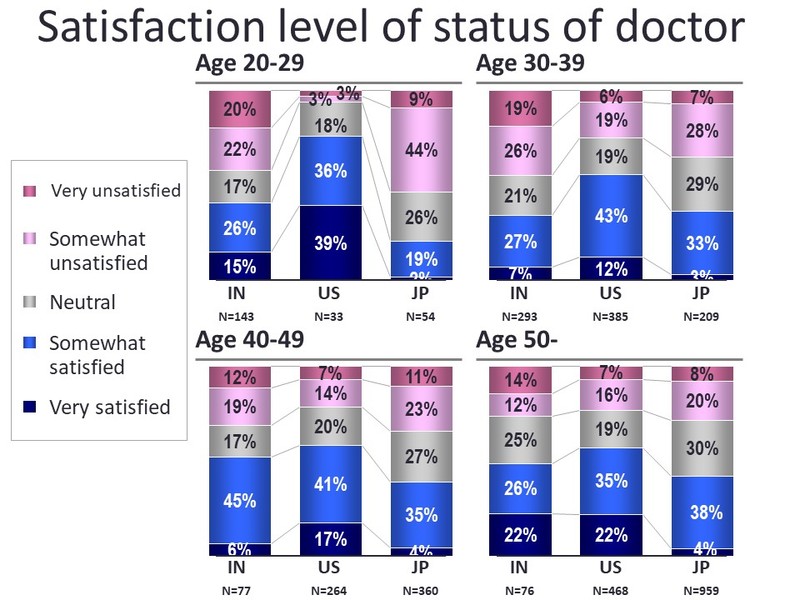How happy are Indian physicians with their practice and career as compared to US and Japan doctors? (M3 India Survey)
M3 India Newsdesk Jul 04, 2018

Professional satisfaction must be the top most-cited reasons for people successful at the professions they choose. Doctors are no exception to this. M3 India’s recent survey aimed to understand physician satisfaction in practice and overall profession and probed the major contributors of low professional satisfaction among doctors.

Here is a look at the results of the Part 3 of the online survey that aimed to question physicians across three countries- India, US, and Japan about professional satisfaction (overall and practice-related) and the factors they considered to be contributing to low work satisfaction.
Satisfaction levels in practice
At the start of their career, Indian doctors don’t seem to be too satisfied at having chosen the profession, but as they advance in age, the satisfaction of having chosen their line of practice sets in.

Only 15% Indian doctors, between ages 20 to 29 seem to be very satisfied at their practice. The low numbers could be attributed to new work environments and increased stress, pressure, and workload, plus very little personal time. US and Japan showed more consistency in this matter across all age groups. However, with age and as they advance in practice, Indian doctors seem to become more happy with their professional practice.
Interestingly, while 70% US doctors between ages 20 and 29 seem to at least be somewhat satisfied with their practice, the percentage of this gradually drops with age, and only 50% agree that they are satisfied with what they do, ages 50 and above.
Overall professional satisfaction
In all three countries, very few doctors seem to be very satisfied with all aspects of the medical profession. India and US both show decrease in professional satisfaction among the age groups of 30 to 39 and 40 to 49, with an increase in the age 50 and above group.

The increase of job satisfaction could be because after age 50 most doctors move into private practice and may be usually free of the extra workload. Most Japanese doctors experience only moderate levels of satisfaction throughout their careers as doctors. In fact, 44% of Japanese doctors who are just starting out have even expressed slight dissatisfaction for the profession.
Factors contributing to low satisfaction
Salary seems to be the major contributing factor for professional dissatisfaction among Indian, American, and Japanese doctors.

Doctors were surveyed on the levels of dissatisfaction they had for various factors like salary, work hours, work relationships, too many on-call days, type of work they are required to do, and other reasons that may not fit into these.
Doctors in all three countries seem to be dissatisfied with how much they earn, with the percentage being high for Indian doctors- 34%. American doctors have also expressed dissatisfaction over work hours (as was evident in Part 1 of the series, US doctors work more than 12 hours a day) and being on call too many days in a week.
Key findings
In this part, some of the findings from comparing professional satisfaction among doctors in India, US, and Japan are:
- Professional satisfaction in practice and overall career increases after a certain age- probably because doctors are more experienced to handle stressful schedules by then and because the additional workload eases up. After 50, most doctors also tend to gain increased autonomy of their work and are hence free to pursue interests within their practice. This could be research, academics, or private practice.
- Income is one of the major reasons why so many doctors feel dissatisfied with the medical profession. Most medics feel that they are not compensated enough for the work they put in. In India at least, the situation could be such that the prime earning period for a doctor is mostly between the ages of 30 and 49, after they have been practicing their chosen specialty for a significant period.
To read part 1 of the global survey, which discusses about work days and work hours for doctors in India, US, and Japan, click here.
To read part 2 of the global survey which discusses physician workload among doctors in India, US, and Japan, click here.
To read part 4 of the survey which discusses about when doctors in India, US, and Japan decide on their career and if they would recommend their professions, click here.
To read part 5 of the survey which investigates how easy or difficult it is for doctors to avail childcare leave in India, US, and Japan, click here.
To read part 6 of the survey which investigates work-life balance of doctors in India, US, and Japan, click here.
To read part 7 of the survey which discusses doctors' views on the healthcare systems in their respective countries- India, US, and Japan, click here.
To read part 8 of the survey which reveals the country that ranks best across various parameters like healthcare system, quality of medical care, work environment, salary, and basic medical reasearch, click here.
*This data should be read as indicative of rather than exact figures.
-
Exclusive Write-ups & Webinars by KOLs
-
Daily Quiz by specialty
-
Paid Market Research Surveys
-
Case discussions, News & Journals' summaries